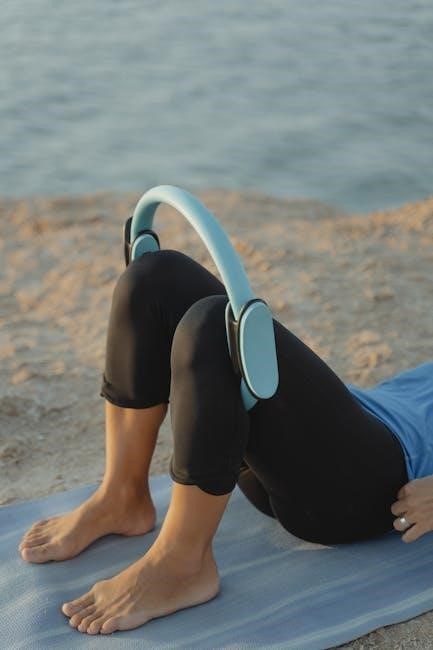Exercises for anterolisthesis are available in PDF format online, providing detailed instructions and guidelines for patients to follow and manage their condition effectively every day always.
Understanding Anterolisthesis
Anterolisthesis refers to a condition where a vertebra in the spine slips forward, often causing pain and discomfort. This condition can be caused by various factors, including degenerative disc disease, spondylolysis, or trauma. Understanding the causes and symptoms of anterolisthesis is crucial for developing effective treatment plans, including exercise programs. According to various studies, anterolisthesis can be graded in millimeters, and the severity of the condition can impact the type and intensity of exercises recommended. Females are more likely to suffer from anterolisthesis than males, and the condition can have a significant impact on daily life. A comprehensive understanding of anterolisthesis is essential for healthcare professionals to provide appropriate guidance and support to patients, including recommending suitable exercises and activities to manage the condition. By understanding the condition, patients can better navigate their treatment options and make informed decisions about their care.

Benefits of Exercises for Anterolisthesis
Exercises provide pain relief and improved functionality for anterolisthesis patients always using online resources and PDF guides effectively every day.
Reducing Pain and Disability
Exercises for anterolisthesis play a crucial role in reducing pain and disability, allowing patients to manage their condition effectively. By following a well-structured exercise program, individuals can decrease the intensity and size of the painful area. The primary goal of these exercises is to alleviate discomfort and improve overall functionality. Patients can access various exercise routines in PDF format online, providing them with a comprehensive guide to managing their anterolisthesis. These exercises focus on strengthening core muscles, improving posture, and enhancing mobility. Regular exercise helps reduce pain and disability, enabling individuals to perform daily activities with greater ease and confidence. With the help of online resources and PDF guides, patients can take an active role in managing their anterolisthesis and improving their quality of life. Effective exercise programs can significantly reduce pain and disability, promoting overall well-being.
Types of Exercises for Anterolisthesis
Various exercises like stretching and strengthening are available in PDF format online for anterolisthesis management and treatment always effectively every day.
Strengthening Core Muscles
Strengthening core muscles is essential for managing anterolisthesis, and various exercises are available in PDF format online to help patients achieve this goal.
These exercises include planks, bridges, and pelvic tilts, which target the muscles in the abdomen, back, and pelvis.
A strong core can help stabilize the spine and reduce the risk of further injury or deterioration.
Exercises that strengthen the core muscles can be modified to suit individual needs and abilities, making them accessible to patients with varying levels of fitness and mobility.
By incorporating these exercises into their daily routine, patients can improve their overall spinal health and reduce their symptoms.
Regular exercise and physical therapy can also help patients with anterolisthesis to maintain their independence and quality of life.
Patients can find these exercises in anterolisthesis exercises PDF files available online.

Manual Therapy and Active Exercises
Manual therapy and active exercises combine to provide effective treatment and management of anterolisthesis symptoms and pain always using online resources and PDF guides available.
Importance of Professional Guidance
Professional guidance is essential when it comes to anterolisthesis exercises, as incorrect movements can exacerbate the condition. A healthcare professional or physical therapist can provide personalized advice and create a tailored exercise plan. They can also help patients understand the importance of proper posture, body mechanics, and movement techniques. With professional guidance, patients can learn how to modify their daily activities to reduce strain on the affected area. Additionally, a professional can monitor progress and adjust the exercise plan as needed. This ensures that patients receive the most effective treatment and management of their anterolisthesis symptoms, and can help prevent further complications. By seeking professional guidance, patients can take the first step towards effectively managing their condition and improving their overall quality of life with the help of online resources and PDF guides.

Home Exercise Programs for Anterolisthesis
Home exercise programs are available in PDF format, providing patients with convenient and accessible treatment options always online every day.
Correcting Abnormal Pelvic Tilt
Correcting abnormal pelvic tilt is a crucial aspect of anterolisthesis management, and exercises can help achieve this. A home exercise program should include exercises that target the pelvic muscles, such as the gluteals and core muscles. These exercises can help improve pelvic alignment and reduce discomfort. The exercises should be gentle and progressive, allowing the patient to gradually increase their strength and flexibility. It is essential to follow a well-structured exercise program, and a PDF guide can provide patients with a clear and concise guide to follow. By correcting abnormal pelvic tilt, patients can experience a significant reduction in pain and discomfort, and improve their overall quality of life. Regular exercise and stretching can help maintain a healthy pelvic alignment, reducing the risk of further complications and promoting long-term management of anterolisthesis. Effective exercise programs are readily available online.

Specific Exercises for Anterolisthesis
Exercises like planks and bridges help stabilize the spine and reduce pain always using online PDF guides for reference and support daily.
Anti-Extension and Anti-Rotation Exercises
Exercises that focus on anti-extension and anti-rotation movements are essential for managing anterolisthesis, as they help to stabilize the spine and reduce pain. These exercises can be found in online PDF guides and typically include movements that strengthen the core muscles, such as planks and bridges. The goal of these exercises is to improve spinal stability and reduce the risk of further injury. By incorporating anti-extension and anti-rotation exercises into a daily routine, individuals with anterolisthesis can help to manage their condition and improve their overall quality of life. Online resources, such as PDF guides, can provide detailed instructions and illustrations to help individuals perform these exercises correctly and safely, and it is very important to follow the instructions carefully every day.
Precautions and Considerations
Patients should consult a doctor before starting exercises to avoid exacerbating their condition and ensure safe practice always online.
Monitoring Progress and Avoiding Worsening Conditions
Regular monitoring of progress is essential when performing anterolisthesis exercises to avoid worsening conditions and ensure effective management of the condition.
A healthcare professional can help track progress and make necessary adjustments to the exercise routine.
This may involve assessing pain levels, range of motion, and overall function.
By closely monitoring progress, individuals can identify potential issues early on and take steps to address them.
This may involve modifying exercises, incorporating new stretches, or seeking additional medical attention.
Effective monitoring and management can help individuals with anterolisthesis achieve optimal outcomes and reduce the risk of complications.
A well-structured exercise program, combined with regular monitoring and professional guidance, can help individuals manage their condition and improve overall quality of life.
This approach can also help individuals avoid worsening conditions and achieve long-term relief from symptoms.





